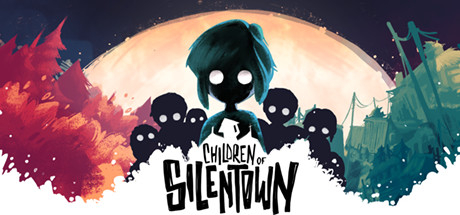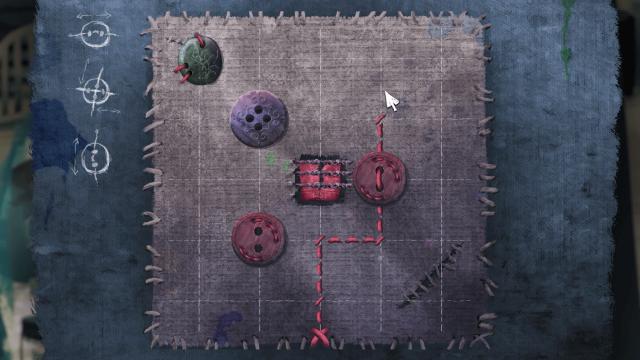Existing User Log In
New User Registration
Register for a free account to gain full access to the VGChartz Network and join our thriving community.





America - Front


America - Back

Elf Games
Adventure
 (Add Date)
(Add Date) (Add Date)
(Add Date) (Add Date)
(Add Date)
| Owners: | 0 |
| Favorite: | 0 |
| Tracked: | 0 |
| Wishlist: | 0 |
| Now Playing: | 0 |
The third title from Elf Games (in collaboration with Luna2 Studios) opens with a mellifluous narrator lyrically describing how fear is “often the hardest disease to treat.” She continues on how Silentown’s social fabric is deeply wedded to fear by the monsters that prowl within the surrounding forest at night. It’s the type of opening you could expect from a grim-dark fairy tale. It sets an appropriate mood for the protagonist, Lucy, as she wakes from her nightmare. Even in their sleep, these townspeople aren’t safe from fear. From the start, Children of Silentown dedicates its attention to exploring this town’s hysteria and the subsequent ramifications thereof. The only problem is that’s never adequately answered.
Of course, before rushing into the main catalyst for Lucy’s journey, the first chapter has to establish the standard adventure mechanics and Silentown’s unique strictures. As every resident knows, the rules pertain to two basic tenets: no staying outside after dark and no loud noises at practically anytime, lest you wake the forest monsters. You can see how this seeps into many aspects of the townspeople’s daily lives: the deep circles around their eyes, very few people interested in music (collecting scarce notes is a mechanic), the ‘missing persons’ board set in the town square, and so on. While everyone tries to occupy themselves with work, play, and/or hobbies, the dour atmosphere is ever-persistent.
That gloominess doesn’t stop Lucy’s avidity towards exploring though. Once the story eventually gets to its critical juncture that impels her to investigate the disappearances, there’s a stronger tension between the adults and Lucy. It’s a dynamic that’s been played out several times before: kids’ inherent curiosity versus adults' pugnacious adherence to rules. Perhaps this split could also be too messy; after all, it won’t take long for Lucy to see wildly disparate responses from kids and adults when someone close to them has been snatched. Even though the pacing dawdles too much, that extra time is sporadically used to show the emotional repercussions amongst the community.
Yet Elf Games’ aspirations for this fairy tale sets a standard it rarely meets. The crux of the problem comes down to writing consistently. Across the modest array of townspeople, there’s not much substantial characterization given to anyone besides Lucy – save for an artificial ending scenario (more on that soon). You’ll spend several hours with Silentown’s inhabitants and yet never see them as much beyond “the trickster” or “the bully” caricatures and the next puzzle pit stop. There isn’t that sense of natural growth stemming from your actions; in fact, a few threads are haphazardly discarded altogether. Continue to stare into their sunken eyes for ages, but you'll never see an honest soul.
This sense of emptiness comes to a head at the finale. If you’re familiar with old or modern fables, you can probably glean what the wider lesson will highlight. What’s the one thing someone needs to conquer fear? Even if the game’s basic answer is true, the problem is the building blocks to arrive at said conclusion crumble under scrutiny. It’s a weird case of the plot progressing whilst character motivations keep spinning their wheels. All of which eventually culminates in deciding one of four maudlin endings, none of which feel earned.
Although I’m lathering Silentown’s tawdry writing a bit thick, it’s tough to grasp substantial positives by the end. Some of the ways Lucy explores the town’s sustained losses is solid world-building. How can a society grow with this decades-old threat constantly looming outside of their town? How that gloomy outlook seeps into everyone in different ways can be worth exploring. It’s just the overarching structure is so mismanaged with regards to lopsided pacing, character consistency, and so on that it ultimately sullies its better qualities.
One integral way Silentown explores these characters is through music. Either through unmissable story beats or exploration, Lucy will uncover notes that correspond to one specific song. Gathering all three unlock said song to be used to either rekindle a memory, peer into the past, or something else. Rekindling a character’s childhood memory is the most thematically & mechanically rewarding of the bunch. Seeing the animated thought bubble nearly rip in twain and re-sewing it together perfectly fits the world’s tone. Out of the various conundrums, those line puzzles rank among the most consistent in terms of pacing and creativity.
The same can’t be said for another collection of song-initiated brainteasers: power-conversion puzzles. Not long after being introduced, the complexity of using gears to shift tiles increases dramatically. I’m all for testing players’ adroit thinking, but not through such a steep incline. These increased demands specifically for gear puzzles subsequently challenge the overall inconsistency. Between singing to the right person at the correct time, those themed logic puzzles, or environmental ones within world, you can get whiplash from the wild variations in difficulty.
Even the more basic puzzles can feel misguided. If you’ve played an adventure game, you know the rules: collect scattered items to match with an obstacle. Sometimes combining items may be necessary, like a big hook and a bed sheet to make a grappling hook. While oftentimes fair in their ultimate goal, a notable few rely on hinting towards potential item combos or whatnot but ultimately do nothing. It’s ironically more productive to think less about several puzzles to succeed; determining which of the implications for said item ultimately mean anything can be the tougher task.
Lack of clarity also extends to Silentown’s otherwise-pleasant visuals. Strictly speaking for its atmosphere, the world is quite lovely. The art style and soundtrack compliment the dour fairy tale; there’s a touch of abstraction in the watercolor backdrops, which provides a nice contrast to the paper-puppet look for character models. As nice as it looks, that occasionally leads to a lack of visual clarity for certain items and routes. Even specific moments in its design will arbitrarily corral towards the preferred pathway.
Those little things, along with a few fundamental errs, doesn’t put Elf Games in the best light. While a 7-8 hour adventure (or less based on puzzle acumen) is perfectly adequate, it should be about squeezing the most with that time, but this team doesn’t seem to appreciate that. For any neat feature like the aesthetics and puzzle design of sewing a character’s memory back, other rips and tears show up as well. The pacing feels lopsided, the difficulty curve varies wildly at times, and other issues with context inhibit earnest engagement.
For a fairy tale with an easily-understood lesson, Children of Silentown can often be much ado about nothing. The unique setup and early world-building is an excellent hook to examine a town living in perpetual fear. To its credit, there are some aspects within its visuals, game design, and narrative that earnestly explore that; and yet, the main adventure ultimately feels aimless by the end. Whether from a grander or more focused scale, several gameplay and story elements can serve as a lesson on what to avoid. Subverting its established rules, there are plenty of reasons to be boisterous about Silentown, not all of them positive.
Contractor by trade and writer by hobby, Lee's obnoxious criticisms have found a way to be featured across several gaming sites: N4G, VGChartz, Gaming Nexus, DarkStation, and TechRaptor! He started gaming in the mid-90s and has had the privilege in playing many games across a plethora of platforms. Reader warning: each click given to his articles only helps to inflate his Texas-sized ego. Proceed with caution.









